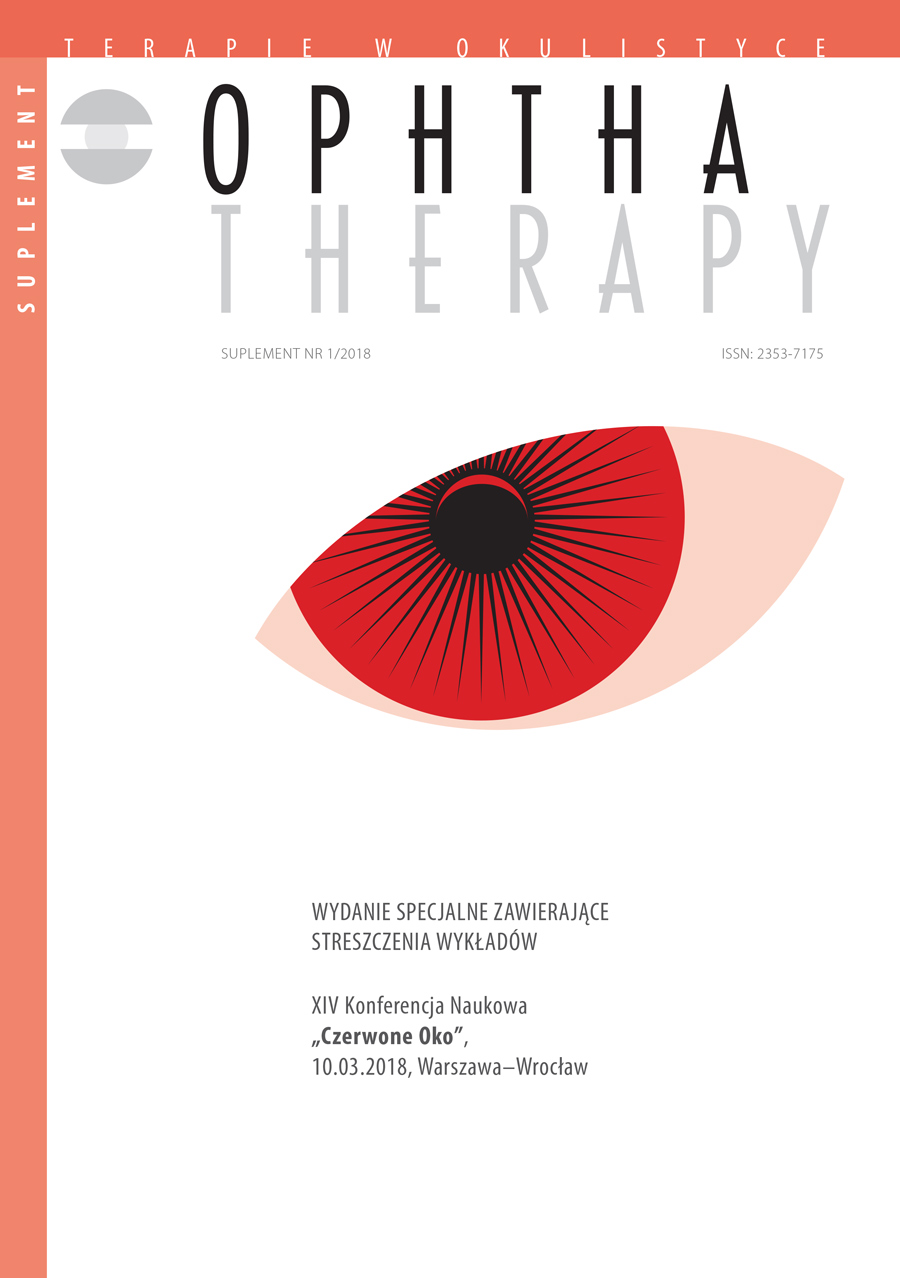The potential risk of eye surface disorders in the use of topical non-steroidal anti-inflammatory drugs – basic clinical facts
Main Article Content
Abstract
The risk of inflammatory complications after cataract surgery is one of the most important challenges of modern ophthalmic surgery. Topical non-steroidal anti-inflammatory drugs since the 1970s have been used in perioperative and postoperative procedures, but due to the potential side effects associated primarily with disturbances in the eye surface (conjunctiva and cornea), their use has raised a number of doubts. The introduction of modern drugs from this group, one of which is nepafenac characterized by unique pharmacological properties and high clinical efficacy, has significantly reduced this problem. The mechanism of action of nepafenac significantly differs from its predecessors and on the one hand significantly improves safety of treatment and on the other thanks to excellent permeability to the posterior segment of the eye provides effective anti-inflammatory activity in the retina reducing the risk of vascular leakage and local edema changes that can negate the success of cataract surgeries especially in patients with diabetes.
Downloads
Article Details

This work is licensed under a Creative Commons Attribution-NonCommercial-NoDerivatives 4.0 International License.
Copyright: © Medical Education sp. z o.o. License allowing third parties to copy and redistribute the material in any medium or format and to remix, transform, and build upon the material, provided the original work is properly cited and states its license.
Address reprint requests to: Medical Education, Marcin Kuźma (marcin.kuzma@mededu.pl)
References
2. Miyake K, Ibaraki N. Prostaglandins and cystoid macular edema. Surv Ophthalmol. 2002; 47(suppl 1): 203-18.
3. Miner J, Hoffhines A. The discovery of aspirin’s antithrombotic effects. Tex Heart Inst J. 2007; 34(2): 179-86.
4. Miyake K. Prevention of cystoid macular edema after lens extraction by topical indomethacin (I). A preliminary report. Albrecht Von Graefes Arch Klin Exp Ophthalmol. 1977; 203(2): 81-8.
5. Ahuja M, Dhake AS, Sharma SK et al. Topical ocular delivery of NSAIDs. AAPS J. 2008; 10: 229-41.
6. Flach AJ. Corneal melts associated with topically applied nonsteroidal anti-inflammatory drugs. Trans Am Ophthalmol Soc. 2001; 99: 205-10.
7. Guidera AC, Luchs JI, Udell IJ. Keratitis, ulceration, and perforation associated with topical nonsteroidal anti inflammatory drugs. Ophthalmology. 2001; 108: 936-44.
8. Walters T, Raizman M, Ernest P et al. In vivo pharmacokinetics and in vitro pharmacodynamics of nepafenac, amfenac, ketorolac, and bromfenac. J Cataract Refract Surg. 2007; 33: 1539-45.
9. Chastain JE, Sanders ME, Curtis MA et al. Distribution of topical ocular nepafenac and its active metabolite amfenac to the posterior segment of the eye. Exp Eye Res. 2016; 45: 58-67.
10. Singh RP, Lehmann R, Martel J et al. Nepafenac 0.3% after Cataract Surgery in Patients with Diabetic Retinopathy. Ophthalmology. 2017; 124: 776-85.
11. Singh R, Alpern L, Jaffe GJ et al. Evaluation of nepafenac in prevention of macular edema following cataract surgery in patients with diabetic retinopathy. Clin Ophthalmol. 2012; 6: 1259-69.
12. Miyake K, Ota I, Miyake G et al. Nepafenac 0.1% versus fluorometholone 0.1% for preenting cystoid macular edema after cataract surgery. J Cataract Refract Surg. 2011; 37: 1581-8.
13. Zaczek A, Artzen D, Laurell CG. Nepafenac 0.1% plus dexamethasone 0.1% versus dexamethasone alone: Effect on macular swelling after cataract surgery. J Cataract Refract Surg. 2014; 40: 1498-505.
14. Charakterystyka produktu leczniczego Nevanac 1 mg/ml.
15. Charakterystyka produktu leczniczego Nevanac 3 mg/ml.
16. Paaraj D, Shah K, Ramchandani B et al. Effect of nepafenac eye drops on intraocular pressure: a randomised prospective study. Am J Ophtalmol. 2014; 157: 735-8.
17. Kawahara A, Utsunomiya T, Kato Y et al. Comparison of effect of nepafenac and diclofenac ophtalmic solutions on cornea, tear film, and ocular surface after cataract surgery: the results of a randomized trial. Clinical Ophtalmology. 2016; 10: 385-91.
18. Afrashi F, Hashas ASK, Shahbazov C et al. Reliability of intavitreal nepafenac in rabbits. J Ocul Pharmacol Ther. 2015; 31(1): 43-50.
19. Polakowska M, Piotrowski W. Incidence of diabetes in the Polish population. Pol Arch Med Wewn. 2011; 121(5): 156-63.
20. Stanowisko Grupy Ekspertów Polskiego Towarzystwa Okulistycznego w sprawie stosowania nepafenaku w profilaktyce pooperacyjnego obrzęku plamki powstałego wskutek chirurgicznego leczenia zaćmy u chorych na cukrzycę. Klin Oczna. 2016; 118(2): 155-160.

